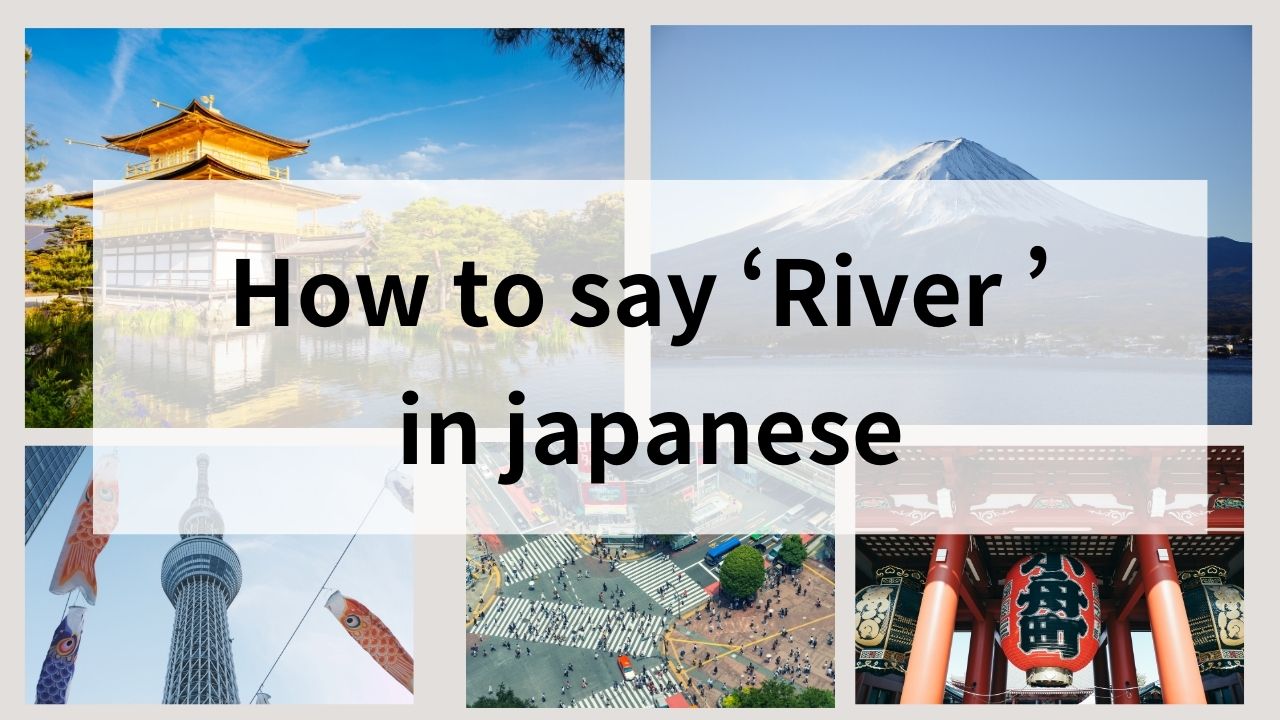Are you curious about how to say “river” in Japanese? Rivers hold significant importance in Japanese culture, geography, and daily life. This guide will explore the Japanese word for “river,” its various uses, and its cultural significance.
How Do You Say “River” in Japanese?
The Japanese word for “river” is 川 (kawa). This term is widely used in both casual and formal contexts when referring to rivers throughout Japan.
The Japanese Word for River: Kawa (川)
“Kawa” is a term used to describe a river and appears in various phrases and contexts. For example:
- 川の水 (Kawa no mizu): “River water.”
- 川沿い (Kawazoi): “Along the river.”
- 川遊び (Kawaasobi): “River play,” referring to activities like swimming or playing in the river.
Kanji for River: 川
The kanji for river, 川, is commonly used in literature, maps, and everyday language. This character not only represents rivers but is also used in compound words related to water. The primary reading for this kanji is かわ (Kawa).
Examples of words containing the kanji 川 include:
- 河川 (Kasen): “Rivers and streams,” referring to the broader system of waterways.
- 川岸 (Kawagishi): “Riverbank,” the land alongside a river.
- 川流れ (Kawagatare): “River flow,” describing the current of a river.
This kanji is often associated with natural landscapes and is essential for understanding geographical features in Japan.
Does “River” Work in Japanese?
The English word “river” is generally understood in Japan, especially among younger generations or those familiar with English. However, its recognition might be less universal among older individuals or in more traditional contexts. A 5-point scale rates its comprehension as:
- Rating: 4 – Generally understood (60-80% of people)
If clarity is crucial, using the Japanese term 川 (Kawa) is recommended. While “river” may be understood in certain contexts, “kawa” ensures effective communication.
The Cultural Significance of Rivers in Japan
Rivers have held a special place in Japanese culture for centuries, symbolizing life, purity, and nature’s beauty. They are often featured in literature, art, and festivals.
Rivers as Symbols of Life
In Japan, rivers are considered sources of life and nourishment, essential for agriculture and daily living. Many traditional beliefs hold that rivers are sacred, embodying spirits that protect the land and its people.
Rivers in Japanese Folklore and Mythology
Rivers appear in various Japanese myths and stories, often symbolizing the journey of life and the connection between the physical and spiritual worlds. They are sometimes depicted as pathways for deities and spirits.
In modern culture, rivers remain a popular theme in art, literature, and media, reflecting their enduring significance in Japanese society.
- The Tale of the Heike: This famous epic features the River Heike, symbolizing the impermanence of life and the struggles of the warrior class.
- Haiku Poetry: Many haiku poems focus on rivers, capturing their beauty and transience, often reflecting the changing seasons.
- Anime and Manga: Rivers are often depicted in scenes of tranquility and reflection, emphasizing character development and emotional moments.
These examples demonstrate how rivers continue to represent life, change, and the interconnectedness of nature and humanity in Japanese culture.
Differences Between Rivers in Japan and Overseas
Yes, there can be subtle differences in how rivers are perceived in Japan versus other countries. In Japan, rivers often have cultural and spiritual significance, viewed as guardians of the land. Meanwhile, in many Western contexts, rivers may be primarily seen as resources for transportation, industry, or recreation. Understanding these cultural nuances can help avoid misunderstandings, especially when discussing natural landscapes in different contexts.
Practical Applications of “River” in Japanese
Learning how “river” is used in Japanese can help you navigate conversations, understand idioms, and recognize its presence in Japanese culture.
Talking About Rivers in Daily Conversation
Here are some examples of how “kawa” is used in everyday conversation:
- 川に行きます (Kawa ni ikimasu): “I will go to the river.”
- 川で泳ぎます (Kawa de oyogimasu): “I will swim in the river.”
River-Related Idioms or Expressions
While there are fewer specific idioms involving “kawa,” rivers are often associated with themes of flow, change, and life. Here are some idioms and phrases that incorporate or symbolize rivers:
- 川の流れ (Kawa no nagare): “The flow of the river,” symbolizing the passage of time and life’s journey.
- 川を渡る (Kawa o wataru): “To cross the river,” often used metaphorically to signify overcoming challenges or obstacles.
- 川柳 (Senryu): A form of Japanese poetry similar to haiku, often humorous, reflecting on human nature and experiences, often using nature themes including rivers.
These idioms and expressions reflect the deep cultural and aesthetic appreciation of rivers in Japan, often tied to themes of life’s journey and natural beauty. By learning these phrases, you can gain a deeper understanding of how rivers are interwoven with Japanese language and values.
Rivers in Japanese Cuisine or Products
Rivers are also prominently featured in Japanese cuisine and products, showcasing their importance in providing fresh ingredients. Here are some notable examples:
- Freshwater Fish (淡水魚, Tansui-gyo): Fish like ayu (鮎) and sweetfish (鮎) are often caught in rivers, prized for their delicate flavor and freshness.
- River Shrimp (川エビ, Kawa ebi): These small shrimp are often used in soups and sushi, celebrated for their sweet taste.
- Wild Vegetables (山菜, Sansai): Many wild vegetables grow near riverbanks and are harvested for their unique flavors, often featured in traditional dishes.
These examples highlight how rivers contribute not only to the ecosystem but also to the culinary richness of Japanese culture.
FAQs
Here are some frequently asked questions about rivers in Japanese culture and language.
Are Rivers Popular in Japan?
Yes, rivers are highly regarded in Japan, often associated with beauty, tranquility, and nature. They are popular destinations for recreational activities and are celebrated in festivals.
How Do You Write “River” in Japanese?
The word “river” can be written in three different scripts in Japanese: hiragana, katakana, and kanji. Each script serves different purposes depending on the context and formality. Here’s a breakdown:
- Hiragana (かわ, Kawa):
Hiragana is commonly used for “river” in casual writing or when teaching children. It is simple and easy to read, making it ideal for everyday use. - Katakana (カワ, Kawa):
Katakana is rarely used for “river,” but it may appear in stylistic contexts, such as advertisements, product names, or when emphasizing the word in text. - Kanji (川, Kawa):
Kanji is the most formal and traditional way to write “river.” It is often used in literature, official documents, and cultural contexts. The kanji itself conveys a sense of elegance and significance.
Choosing which script to use depends on the tone, audience, and purpose of your communication. Understanding these variations can enhance both your written and spoken Japanese skills.
Conclusion
Rivers, or “kawa” in Japanese, are more than just geographical features—they symbolize life, nature, and cultural significance. By understanding their role in Japanese language and traditions, you can deepen your appreciation for these vital waterways and their place in Japanese society.








